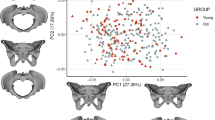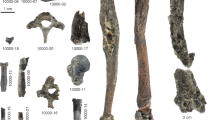Abstract
As predicted by Darwin1, bipedal posture and locomotion are key distinguishing features of the earliest known hominins2,3. Hominin axial skeletons show many derived adaptations for bipedalism, including an elongated lumbar region, both in the number of vertebrae and their lengths, as well as a marked posterior concavity of wedged lumbar vertebrae, known as a lordosis4,5,6. The lordosis stabilizes the upper body over the lower limbs in bipeds by positioning the trunk’s centre of mass (COM) above the hips. However, bipedalism poses a unique challenge to pregnant females because the changing body shape and the extra mass associated with pregnancy shift the trunk’s COM anterior to the hips. Here we show that human females have evolved a derived curvature and reinforcement of the lumbar vertebrae to compensate for this bipedal obstetric load. Similarly dimorphic morphologies in fossil vertebrae of Australopithecus suggest that this adaptation to fetal load preceded the evolution of Homo.
This is a preview of subscription content, access via your institution
Access options
Subscribe to this journal
Receive 51 print issues and online access
$199.00 per year
only $3.90 per issue
Buy this article
- Purchase on Springer Link
- Instant access to full article PDF
Prices may be subject to local taxes which are calculated during checkout




Similar content being viewed by others
References
Darwin, C. The Descent of Man (John Murray, London, 1871)
Galik, K. et al. External and internal morphology of the BAR 1002′00 Orrorin tugenensis femur. Science 305, 1450–1453 (2004)
Zollikofer, C. P. E. et al. Virtual cranial reconstruction of Sahelanthropus tchadensis . Nature 434, 755–759 (2005)
Robinson, J. T. Early Hominid Posture and Locomotion (Univ. of Chicago Press, Chicago, 1972)
Sanders, W. J. Comparative morphometric study of the australopithecine vertebral series Stw-H8/H41. J. Hum. Evol. 34, 249–302 (1998)
Latimer, B. & Ward, C. V. in The Nariokotome Homo erectus Skeleton (eds Walker, A. & Leakey, R.) 266–293 (Harvard Univ. Press, Cambridge, MA, 1993)
Strassmann, B. I. The biology of menstruation in Homo sapiens: total lifetime menses, fecundity, and nonsynchrony in a natural-fertility population. Curr. Anthropol. 38, 123–129 (1997)
Jensen, R. K., Doucet, S. & Treitz, T. Changes in segment mass and mass distribution during pregnancy. J. Biomech. 29, 251–256 (1996)
White, A. A. & Punjabi, M. M. Clinical Biomechanics of the Spine (Lippincott, Philadelphia, 1990)
Bogduk, N. Clinical Anatomy of the Lumbar Spine and Sacrum (Churchill Livingstone, New York, 1997)
Ostgaard, H. C., Andersson, G. B. J., Schultz, A. B. & Miller, J. A. A. Influence of some biomechanical factors on low-back pain in pregnancy. Spine 18, 61–65 (1993)
Dumas, G. A., Reid, J. G., Griffin, M. P. & McGrath, M. J. Exercise, posture, and back pain during pregnancy. Part 1. Exercise and posture. Clin. Biomech. 10, 98–103 (1995)
Pal, G. P. & Routal, R. V. Transmission of weight through the lower thoracic and lumbar regions of the vertebral column in man. J. Anat. 152, 93–105 (1987)
Adams, M. A. & Hutton, W. C. The effect of posture on the role of the apophyseal joints in resisting intervertebral compressive forces. J. Bone Joint Surg. Br. 62, 358–362 (1980)
Lorenz, M., Patwardhan, A. & Vanderby, R. Load-bearing characteristics of lumbar facets in normal and surgically altered spinal segments. Spine 8, 122–130 (1983)
Dunlop, R. B., Adams, M. A. & Hutton, W. C. Disc space narrowing and the lumbar facet joints. J. Bone Joint Surg. Br. 66, 706–710 (1984)
Lee, D. R., Kuehl, T. J. & Eichberg, J. W. Real-time ultrasonography as a clinical and management tool to monitor pregnancy in a chimpanzee breeding colony. Am. J. Primatol. 24, 289–294 (1991)
DeSilva, J. & Lesnik, J. Chimpanzee neonatal brain size: Implications for brain growth in Homo erectus . J. Hum. Evol. 51, 207–212 (2006)
Institute of Medicine of the National Academies. Nutrition During Pregnancy. Part 1. Weight Gain (National Academy Press, Washington DC, 1990)
Alexander, G. R., Himes, J. H., Kaufman, R. B., Mor, J. & Kogan, M. A United States national reference for fetal growth. Obstet. Gynecol. 87, 163–168 (1996)
Washburn, S. L. Sex differences in the pubic bone. Am. J. Phys. Anthropol. 6, 199–207 (1948)
Schultz, A. H. Sex differences in the pelves of primates. Am. J. Phys. Anthropol. 7, 401–423 (1949)
Rosenberg, K. & Trevathan, W. Bipedalism and human birth: The obstetrical dilemma revisited. Evol. Anthropol. 4, 161–168 (1996)
Arensburg, B. in Le Squelette Mousterien de Kebara 2 (eds Bar Yosef, O. & Vandermeersch, B.) 113–146 (Cahiers de Paléoanthropologie, Paris, 1991)
Trinkaus, E. The Shanidar Neandertals (Academic, New York, 1983)
Jungers, W. L. Relative joint size and hominoid locomotor adaptations with implications for the evolution of hominid bipedalism. J. Hum. Evol. 17, 247–265 (1988)
Ruff, C. B. in Primate Locomotion: Recent Advances (eds Strasser, E., Fleagle, J., Rosenberger, A. & McHenry, M.) 449–469 (Plenum, New York, 1998)
Bramble, D. M. & Lieberman, D. E. Endurance running and the evolution of Homo . Nature 432, 345–352 (2004)
Zatsiorsky, V. & King, D. An algorithm for determining gravity line location from posturographic recordings. J. Biomech. 31, 161–164 (1998)
Phenice, T. W. A newly developed visual method of sexing in the Os pubis . Am. J. Phys. Anthropol. 30, 297–301 (1969)
Ubelaker, D. H. & Volk, C. G. A test of the Phenice method for the estimation of sex. J. Forensic Sci. 47, 19–24 (2002)
Washburn, S. L. & Buettner-Janusch, J. The definition of thoracic and lumbar vertebrae. Am. J. Phys. Anthropol. 10, 251–252 (1952)
Shapiro, L. in Postcranial Adaptation in Nonhuman Primates. (ed. Gebo, D.L.) 121-149 (Northern Illinois University Press, DeKalb, IL, 1993)
Schultz, A. H. The skeleton of the trunk and limbs of higher primates. Hum. Biol. 2, 303–438 (1930)
Rockwell, H., Gaynor Evans, F. & Pheasant, H. The comparative morphology of the vertebrate spinal column: its form as related to function. J. Morphol. 63, 87–117 (1938)
Digiovanni, B., Scoles, P. & Latimer, B. Anterior extension of the thoracic vertebral bodies in Scheuermann’s kyphosis: an anatomic study. Spine 14, 712–716 (1989)
Corruccini, R. S. Shape in morphometrics: comparative analyses. Am. J. Phys. Anthropol. 73, 289–303 (1987)
Jungers, W. L., Falsetti, A. B. & Wall, C. E. Shape, relative size, and size-adjustments in morphometrics. Yb. Phys. Anthropol. 38, 137–161 (1995)
Mosimann, J. Size allometry: Size and shape variables with characterizations of the log normal and gamma distributions. J. Am. Stat. Assoc. 65, 930–945 (1970)
Darroch, J. & Mosimman, J. Canonical and principal components of shape. Biometrika 72, 241–252 (1985)
Sokal, R. R. & Rohlf, F. J. Biometry: The Principles and Practice of Statistics in Biological Research. 3rd Edition. (W.H. Freeman and Company, New York, 1995)
Jaccard, J. & Wan, C. K. LISREL Approaches to Interaction Effects in Multiple Regression (Sage, Thousand Oaks, CA, 1996)
Acknowledgements
We thank W. Sanders for fossil measurements and discussion; S. Ford, J. Jensen, J. Kappelman, D. Overdorff, D. Pilbeam, D. Raichlen, P. Rightmire and C. Ruff for comments and assistance with research; L. Gordon, D. Hunt, L. Jellema, B. Latimer and R. Thorington for access to specimens; and the Developmental Motor Control Laboratory at the University of Texas, Austin, for laboratory use. Figure 1 was drawn by L. Meszoly. This work was supported by grants from the National Science Foundation (to L.J.S. and K.K.W.), the L. S. B. Leakey Foundation (to K.K.W.), the National Science Foundation (to D.E.L.) and the American School of Prehistoric Research (Harvard).
Author Contributions K.K.W. designed the study, conducted the experiments, and analysed and interpreted the data. L.J.S. assisted in the study design and the interpretation of results. D.E.L. assisted in the fossil study design and in the analysis and interpretation of the fossil and biomechanical data. K.K.W., L.J.S. and D.E.L. wrote the manuscript.
Author information
Authors and Affiliations
Corresponding author
Supplementary information
Supplementary Information
The file contains Supplementary Tables 1-3, Supplementary Notes and additional references. (PDF 283 kb)
Rights and permissions
About this article
Cite this article
Whitcome, K., Shapiro, L. & Lieberman, D. Fetal load and the evolution of lumbar lordosis in bipedal hominins. Nature 450, 1075–1078 (2007). https://doi.org/10.1038/nature06342
Received:
Accepted:
Issue Date:
DOI: https://doi.org/10.1038/nature06342
This article is cited by
-
Evidence that the aesthetic preference for Hogarth’s Line of Beauty is an evolutionary by-product
Scientific Reports (2023)
-
Structural equation modeling of female gait attractiveness using gait kinematics
Scientific Reports (2023)
-
The evolution of pelvic canal shape and rotational birth in humans
BMC Biology (2021)
-
Forensic sex estimation using the vertebrae: an evaluation on two European populations
International Journal of Legal Medicine (2020)
-
3D shape analyses of extant primate and fossil hominin vertebrae support the ancestral shape hypothesis for intervertebral disc herniation
BMC Evolutionary Biology (2019)
Comments
By submitting a comment you agree to abide by our Terms and Community Guidelines. If you find something abusive or that does not comply with our terms or guidelines please flag it as inappropriate.



